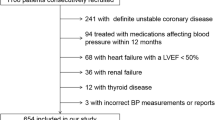Abstract
Background
The pathophysiology of microvascular angina (cardiac syndrome X, CSX), (effort-induced angina, a positive response to exercise stress testing and angiographically normal coronary arteries) has not been fully elucidated. Various pathogenic mechanisms have been proposed, amongst which coronary microvascular dysfunction features prominently. Management of patients with microvascular angina is often challenging as a substantial number of patients does not respond to conventional anti-anginal therapy. In this study, we sought to assess the association between brachial artery FMD, high-sensitive C-reactive protein (hs-CRP) and cardiovascular risk factors including obesity in patients with cardiac syndrome X.
Methods and results
Thirty-four consecutive CSX patients (29 female, mean age 60 ± 9 years) were recruited from a specialised CSX clinic. Twelve asymptomatic subjects (10 female, mean age 51 ± 12 years) with comparable cardiovascular risk factor profile served as controls. All participants underwent standardized computer-assisted FMD measurements and assessment of hs-CRP concentrations at study entry. Body mass index (BMI), used as a general measure of obesity was calculated as weight (kilograms) divided by height (meters squared). Compared to controls, CSX patients had significantly higher hs-CRP concentrations (p = 0.003) and impaired FMD (p < 0.01). Moreover, among the CSX patients, a correlation between FMD and hs-CRP (r = −0.66, p < 0.01), FMD and BMI (r = 0.377, p = 0.028), and hs-CRP and BMI (r = −0.372, p = 0.030) was found.
Conclusion
Impaired brachial artery FMD is significantly associated with elevated hs-CRP concentrations and BMI in patients with CSX. The results support the concept that low-grade inflammation and obesity may promote vascular dysfunction in these patients representing therapeutic targets for future research investigations.

Similar content being viewed by others
References
Kaski JC. Pathophysiology and management of patients with chest pain and normal coronary arteriograms (cardiac syndrome X). Circulation. 2004;109:568–72.
Maseri A, Crea F, Kaski JC, Crake T. Mechanisms of angina pectoris in syndrome X. J Am Coll Cardiol. 1991;17:499–506.
Camici PG, Crea F. Coronary microvascular dysfunction. N Engl J Med. 2007;356:830–40.
Lanza GA. Cardiac syndrome X: a critical overview and future perspectives. Heart. 2007;93:159–66.
Lekakis JP, Papamichael CM, Vemmos CN, Voutsas AA, Stamatelopoulos SF, Moulopoulos SD. Peripheral vascular endothelial dysfunction in patients with angina pectoris and normal coronary arteriograms. J Am Coll Cardiol. 1998;31:541–6.
Masci PG, Laclaustra M, Lara JG, Kaski JC. Brachial artery flow-mediated dilation and myocardial perfusion in patients with cardiac syndrome X. Am J Cardiol. 2005;95:1478–80.
Libby P, Ridker PM, Maseri A. Inflammation and atherosclerosis. Circulation. 2002;105:1135–43.
Ridker PM. Clinical application of C-reactive protein for cardiovascular disease detection and prevention. Circulation. 2003;107:363–9.
Sidhu JS, Newey VR, Nassiri DK, Kaski JC. A rapid and reproducible on line automated technique to determine endothelial function. Heart. 2002;88:289–92.
Blake GJ, Rifai N, Buring JE, Ridker PM. Blood pressure, C-reactive protein, and risk of future cardiovascular events. Circulation. 2003;108:2993–9.
Lanza GA, Crea F. Primary coronary microvascular dysfunction: clinical presentation, pathophysiology, and management. Circulation. 2010;121:2317–25.
Arroyo-Espliguero R, Mollichelli N, Avanzas P, Zouridakis E, Newey VR, Nassiri DK, Kaski JC. Chronic inflammation and increased arterial stiffness in patients with cardiac syndrome X. Eur Heart J. 2003;24:2006–11.
López-Jiménez F, Cortés-Bergoderi M. Update: systemic diseases and the cardiovascular system (i): obesity and the heart. Rev Esp Cardiol. 2011;64:140–9.
Al-Tahami BA, Bee YT, Ismail AA, Rasool AH. Impaired microvascular endothelial function in relatively young obese humans is associated with altered metabolic and inflammatory markers. Clin Hemorheol Microcirc. 2011;47:87–97.
De Rosa S, Cirillo P, Pacileo M, Di Palma V, Paglia A, Chiariello M. Leptin stimulated C-reactive protein production by human coronary artery endothelial cells. J Vasc Res. 2009;46:609–17.
Khera A, Vega GL, Das SR, et al. Sex differences in the relationship between C-reactive protein and body fat. J Clin Endocrinol Metab. 2009;94:3251–8.
Gentile M, Panico S, Rubba F, et al. Obesity, overweight, and weight gain over adult life are main determinants of elevated hs-CRP in a cohort of Mediterranean women. Eur J Clin Nutr. 2010;64:873–8.
Bagi Z, Feher A, Cassuto J. Microvascular responsiveness in obesity: implications for therapeutic intervention. Br J Pharmacol. 2012;165:544–60.
Teragawa H, Fukuda Y, Matsuda K, et al. Relation between C reactive protein concentrations and coronary microvascular endothelial function. Heart. 2004;90:750–4.
Atmaca Y, Ozdol C, Turhan S, Vurgun K, Duzen V, Erol C. The association of elevated white blood cell count and C-reactive protein with endothelial dysfunction in cardiac syndrome X. Acta Cardiol. 2008;63:723–8.
Sakr SA, Abbas TM, Amer MZ, et al. Microvascular angina. The possible role of inflammation, uric acid, and endothelial dysfunction. Int Heart J. 2009;50:407–19.
McKendall MJ, Haier RJ. Pain sensitivity and obesity. Psychiatry Res. 1983;8:119–25.
Kayikcioglu M, Payzin S, Yavuzgil O, Kultursay H, Can LH, Soydan I. Benefits of statin treatment in cardiac syndrome-X1. Eur Heart J. 2003;24:1999–2005.
Pauly DF, Johnson BD, Anderson RD, Handberg EM, Smith KM, Cooper-DeHoff RM, Sopko G, Sharaf BM, Kelsey SF, Merz CN, Pepine CJ. In women with symptoms of cardiac ischemia, nonobstructive coronary arteries, and microvascular dysfunction, angiotensin-converting enzyme inhibition is associated with improved microvascular function: a double-blind randomized study from the National Heart, Lung and Blood Institute Women’s Ischemia Syndrome Evaluation (WISE). Am Heart J. 2011;162:678–84.
Mather KJ, Verma S, Anderson TJ. Improved endothelial function with metformin in type 2 diabetes mellitus. J Am Coll Cardiol. 2001;37:1344–50.
Mehta PK, Goykhman P, Thomson LE, Shufelt C, Wei J, Yang Y, Gill E, Minissian M, Shaw LJ, Slomka PJ, Slivka M, Berman DS, Bairey Merz CN. Ranolazine improves angina in women with evidence of myocardial ischemia but no obstructive coronary artery disease. JACC Cardiovasc. Imaging. 2011;4:514–22.
Charakida M, Masi S, Lüscher TF, Kastelein JJ, Deanfield JE. Assessment of atherosclerosis: the role of flow-mediated dilatation. Eur Heart J. 2010;31:2854–61.
Author information
Authors and Affiliations
Corresponding author
Rights and permissions
About this article
Cite this article
Ong, P., Sivanathan, R., Borgulya, G. et al. Obesity, Inflammation and Brachial Artery Flow-Mediated Dilatation: Therapeutic Targets in Patients with Microvascular Angina (Cardiac Syndrome X). Cardiovasc Drugs Ther 26, 239–244 (2012). https://doi.org/10.1007/s10557-012-6382-4
Published:
Issue Date:
DOI: https://doi.org/10.1007/s10557-012-6382-4




